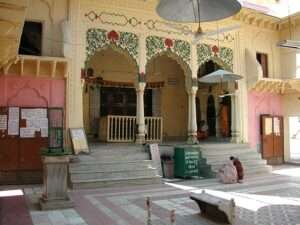
In the year 1535 Jiva Gosvami arrived in Vrindavana and took shelter of Rupa Gosvami, considered the leading Gosvami.
He was welcomed by Santana Gosvami, Raghunath das Gosvami, Raghunatha Bhatta Gosvami, Gopala Bhatta Gosvami, Krishna das Kaviraj Gosvami, Prabodhananada Sarasvati and Kasisvara Pandit.
Jiva Gosvami proved his humility by rendering services like begging alms, cooking, washing Rupa’s feet and preparing manuscripts.
At that time there were no temples, only dense forests and Jiva and Rupa used to live together in the middle of Seva Kunj which was a large area.
Many Vaishnavas used to gather at Seva Kunj to hear Sri Rupa Gosvami explain the Gaudiya philosophy. Living together with the Goswamis were famous personalities like Lokanath das Gosvami, Subuddhi Raya, Raghava Pandit and others.
Rupa Gosvami was expert not only in philosophy and scholarship but also in astrology, mathematics and languages such as Sanskrit, Persian and Bengali.
He was also expert in drawing and carving and able to prepare Deities.
In 1542, during the month of Kartik, knowing Jiva Gosvami’s desire for a Deity, he personally carved, installed and offered a small Deity of Damodara (Krishna) to his foremost disciple.
Before the large temples were built, the Goswamis worshiped their Deities simply, keeping them in the tree under which they slept.
After Sanatana Gosvami’s disappearance in 1558, Jiva Gosvami purchased the land of the area called Seva Kunj. He bought a plot for thirty rupees from Ali Kant Chaudari, Emperor Akbar’s local landlord.
The original deed kept at the Vrindavana Research Institute mentions that the area was located between Seva Kunj, Dan Gali, Imli Tala, Sringhar Sthali and Rasa Sthali.
Its boundaries were marked by four trees: tamarind, banyan, pipal and kadamba.
Jiva Gosvami directed Mansingh Raja of Ajmer in Rajasthan in constructing Radha Damodara Temple.
The opening date remains uncertain since only Radha Madan Mohan Temple (1580) and Radha Govindaji Temple (1590) have inscription dates denoting the year of completion.
On the altar there are four couples of Deities:
Radha Vrindavan Chandra worshiped by Krishna das Kaviraj Gosvami,
Radha Damodara worshiped by Jiva Gosvami,
Radha Madhava worshiped by Jayadeva Gosvami and
Radha Chalachikana of Bhugarbha Gosvami.
There is also a Govardhan shila called Giri Raja Charan Shila, that was worshiped by Sanatana Gosvami and was given to him by Krishna Himself. When Sanatana Gosvami was very old, it was difficult for him to circumambulate Govardhana Hill, so Krishna gave him this shila and told him if he would circumambulate the shila that would be just as good as going around Govardhana Hill.
The samadhis of Jiva Gosvami, Rupa Gosvami and Bhugarbha Gosvami are also here and the bhajan kutirs of Rupa Gosvami and Sri Abhay Caran Bhaktivedanta Swami Prabhupada.
In 1670 Emperor Aurangzeb destroyed many temples of Vrindavan but Radha Damodara Temple was spared because Aurangzeb’s soldiers thought the simply designed temple was a private residence.
Due to the terror of the muslim attacks, the Deities were moved to Jaipur and replaced by “pratibhu” murtis, considered as good as the original ones.
Before Jiva Gosvami disappeared in 1608, he wrote his last will, leaving all the Deities, temples, properties and libraries that he had inherited from Sanatana, Rupa and Raghunath das Gosvami, to Sri Vilas das who was Jiva’s successor as the head priest of the Radha Damodara temple.
Krishna das succeeded Sri Vilas das and the present sevaite is directly coming from his descendants.
This is a section of the book “Brilliant as the Sun”.
To buy the complete book, click above



Leave a Reply